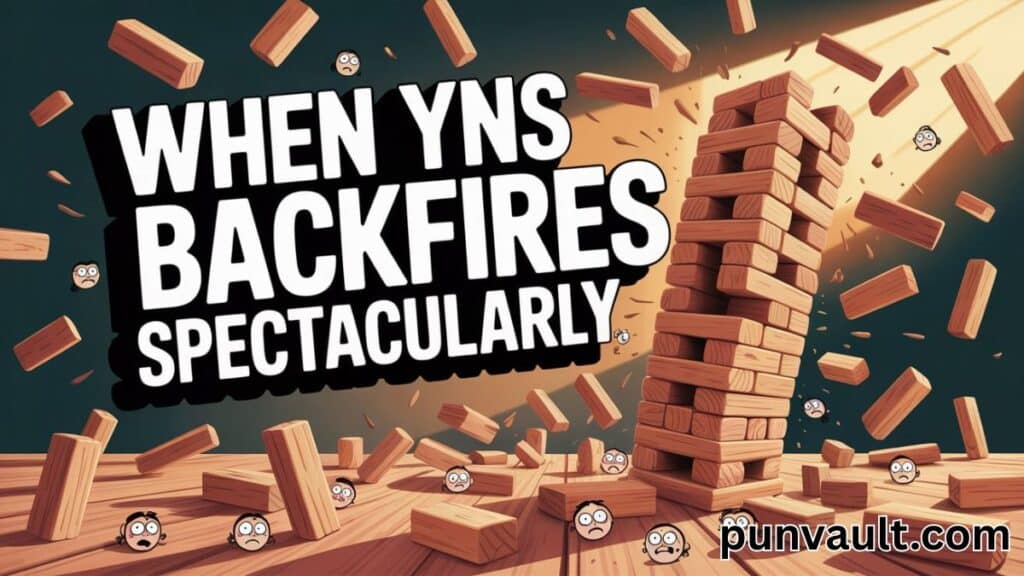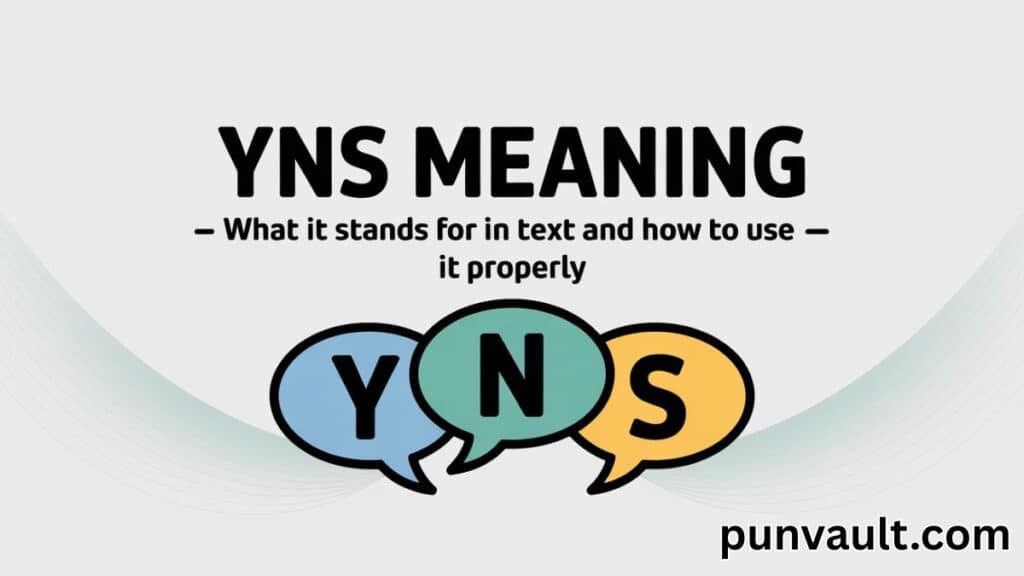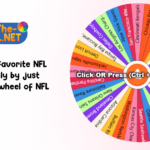YNS meaning refers to the popular texting acronym “You’re Not Serious” — a digital expression used to convey disbelief, shock, or playful skepticism in text messages and social media platforms. This abbreviation has become essential internet slang for expressing surprise across digital communication channels.
Picture receiving earth-shattering news from your best friend and needing the perfect response that captures your amazement without typing a novel. YNS delivers that instant emotional punch, transforming complex feelings into three simple letters that everyone understands.
Mastering YNS in text requires understanding tone, context, and audience awareness. While this messaging slang works brilliantly in casual conversations, using it inappropriately can damage relationships or professional reputation. Learning proper YNS texting etiquette ensures effective modern texting terms usage across all platforms.
What Does YNS Actually Mean?
YNS stands for “You’re Not Serious” — a popular way to express disbelief, shock, or playful skepticism in text messages and social media language. This acronym serves as a quick response when someone shares surprising news or makes an unbelievable claim.
The YNS meaning goes beyond simple disbelief. It carries emotional weight and tone that can range from genuine shock to playful teasing. Unlike formal expressions of doubt, YNS in text creates an informal language bridge between friends and family.
Origins and Evolution
YNS emerged from the natural evolution of texting short forms. As digital communication became faster-paced, people needed quicker ways to express complex emotions. The abbreviation follows the same pattern as other popular texting acronyms like LOL, OMG, and BRB.
Social media platforms accelerated its adoption. Instagram, Twitter, and Snapchat users embraced YNS because it perfectly captured that moment of disbelief we all experience when scrolling through feeds.
| Platform | Usage Frequency | Primary Context |
|---|---|---|
| High | Comments on surprising posts | |
| Snapchat | Very High | Direct message responses |
| Moderate | Reply threads | |
| Text Messages | High | Friend conversations |
| TikTok | Very High | Comment sections |
Where You’ll Encounter YNS Most Often

YNS texting appears everywhere casual expressions dominate. Understanding where this messaging slang thrives helps you recognize context and respond appropriately.
Social Media Dominance
Social media platforms serve as the primary breeding ground for YNS slang. Young users particularly gravitate toward this abbreviation when reacting to viral content, celebrity news, or friend updates.
Instagram comments sections buzz with YNS responses to celebrity announcements. When a favorite influencer drops surprising news, followers flood comments with this acronym. The playful tone fits perfectly with Instagram’s visual-first culture.
TikTok users deploy YNS strategically in comment threads. The platform’s fast-paced nature demands quick reactions, making texting acronyms essential communication tools. A shocking dance trend or unexpected collaboration sparks thousands of YNS responses.
Text Messaging Territory
Text messaging language has fully embraced YNS. Friends use it constantly when sharing gossip, news, or personal updates. The informal language creates intimacy and shared understanding between close contacts.
Group chats particularly love YNS. When someone drops unexpected news into a friend group, multiple YNS responses often flood the chat simultaneously. This creates a digital equivalent of collective gasping.
Gaming Communities
Discord servers and gaming platforms see frequent YNS usage. Gamers react to surprising plays, unexpected wins, or shocking losses with this quick abbreviation. The casual expressions fit gaming culture’s relaxed communication style.
Reading Between the Lines: Tone and Context

Tone in text messages becomes tricky with YNS. The same three letters can convey vastly different meanings depending on context, relationship, and surrounding words.
Playful Disbelief vs. Genuine Shock
YNS walks a fine line between humor and sincerity. Close friends often use it playfully when sharing minor surprises or teasing each other. The sarcastic tone emerges through familiarity and shared history.
Genuine shock produces different YNS usage. Someone receiving truly surprising news — like an engagement announcement or job promotion — uses YNS to express authentic disbelief. The message tone shifts from playful to supportive.
Punctuation Matters
Texting etiquette recognizes how punctuation changes YNS meaning:
- YNS! — Excited disbelief, positive surprise
- YNS? — Questioning, seeking confirmation
- YNS… — Skeptical, potentially negative
- YNS — Neutral reaction, letting context speak
Regional and Cultural Variations
Communication tone varies across regions and age groups. Teenagers might use YNS dozens of times daily, while older adults reserve it for truly shocking moments. Understanding your audience prevents texting tone misinterpretation.
Real Examples of YNS in Action

Seeing YNS in context clarifies its proper usage. These real-world examples demonstrate how digital communication adapts this acronym across different scenarios.
Social Media Scenarios
Friend A: “Just got accepted to Harvard!” Friend B: “YNS! That’s incredible! 🎉”
Instagram Post: “Surprise! We’re pregnant!” Comments:
- “YNS! Congratulations!”
- “Wait… YNS right now??”
- “YNS!! So happy for you both!”
Text Message Conversations
Parent: “Your dad and I are getting matching tattoos” Teenager: “YNS mom… please tell me you’re joking 😂”
Friend 1: “I just won $500 on a scratch-off ticket” Friend 2: “YNS! Buy dinner tonight!”
Gaming Chat Examples
Player 1: “Just got a legendary drop on my first try” Player 2: “YNS… that took me 47 attempts” Player 3: “Screenshots or it didn’t happen YNS”
When YNS Backfires Spectacularly

Professional texting requires careful consideration of audience awareness. YNS can create awkward situations when used inappropriately, leading to damaged relationships or missed opportunities.
Career-Killing Moments
Workplace communication demands formal vs casual texting awareness. Using YNS in professional settings can appear unprofessional or disrespectful. A coworker sharing promotion news doesn’t expect YNS as a response.
Email correspondence never welcomes YNS. The abbreviation clashes with professional register expectations. Clients, supervisors, and colleagues expect thoughtful responses, not internet slang.
Serious Conversation Disasters
Sensitive topics require empathy, not casual expressions. Someone sharing difficult news — health issues, family problems, or personal struggles — needs support, not YNS responses that minimize their experience.
Texting with friends during crises demands linguistic nuance. While YNS works for surprising good news, it fails miserably when friends share problems or seek comfort.
Cultural Misunderstandings
Audience awareness becomes crucial across generations. Older family members might interpret YNS as dismissive or rude. The semantic interpretation varies dramatically based on familiarity with modern texting terms.
International friends might miss YNS meaning entirely. Text-based communication loses paralinguistic cues, making acronyms particularly confusing for non-native speakers.
Better Ways to Express Disbelief

Polite alternatives to YNS expand your digital communication toolkit. These options provide tone flexibility while maintaining clear intent.
Casual Friend Zone Options
Texting with friends allows creative disbelief expressions:
- “Wait, for real?” — Questions authenticity without seeming dismissive
- “You’re messing with me” — Playful doubt that maintains friendship warmth
- “No freaking way” — Emphasizes shock while staying casual
- “Are you being serious rn?” — Modern twist on classic disbelief
- “That’s wild” — Acknowledges surprise without questioning truth
Professional Polish
Workplace messages require sophisticated how to express disbelief:
- “Could you clarify that?” — Seeks information without challenging credibility
- “That’s quite surprising” — Acknowledges shock professionally
- “I wasn’t expecting that” — Personal reaction without judgment
- “That’s remarkable” — Positive spin on surprising information
- “Really? Tell me more” — Encourages elaboration while expressing interest
Maximum Drama Territory
Social media terms embrace theatrical responses:
- “You’ve got to be kidding me” — Classic full-phrase version of YNS
- “Get out of town!” — Vintage expression making digital comeback
- “Shut the front door” — Family-friendly alternative to stronger expressions
- “My jaw just hit the floor” — Visual metaphor for extreme surprise
- “I’m shook” — Modern slang expressing deep impact
Your Quick Decision Guide
Choosing appropriate disbelief expressions requires analyzing multiple factors. This decision framework prevents communication tone disasters.
Relationship Check
Texting etiquette starts with relationship assessment:
- Best friends: YNS works perfectly, matches informal language expectations
- Family members: Consider age gaps and internet slang familiarity
- Coworkers: Skip YNS, choose professional texting alternatives
- Acquaintances: Err toward polite alternatives, avoid potential offense
Situation Scanner
Context determines appropriateness:
- Casual chat: YNS fits naturally into relaxed conversations
- Serious news: Skip abbreviations, choose empathetic responses
- Group settings: Consider all recipients before using messaging slang
- Public platforms: Remember audience awareness on social media platforms
Platform Considerations
Different platforms have distinct communication tone expectations:
| Platform | YNS Appropriateness | Better Alternatives |
|---|---|---|
| Instagram DMs | Perfect | None needed |
| Never | “That’s surprising news” | |
| Text Messages | With friends only | Depends on recipient |
| Twitter Replies | Often acceptable | Consider context |
| Work Slack | Avoid | “Interesting development” |
Consequence Calculator
Before sending YNS, consider potential outcomes:
- Best case: Recipient laughs, conversation continues naturally
- Neutral case: Message understood but not particularly engaging
- Worst case: Offense taken, relationship damaged, professional consequences
YNS Etiquette Masterclass
Mastering YNS usage requires understanding subtle texting etiquette rules that govern digital communication.
Timing Is Everything
Message tone heavily depends on response timing. Immediate YNS responses suggest genuine surprise and engagement. Delayed responses might seem dismissive or uninterested.
Social media language moves quickly. YNS works best as fresh, immediate reactions. Commenting YNS on week-old posts appears awkward and out-of-touch.
Reading the Digital Room
Audience awareness extends beyond individual recipients. Group chats require considering all members’ comfort levels with internet slang. Mixed-age groups might need formal vs casual texting balance.
Social media platforms have distinct cultures. Instagram embraces casual expressions, while LinkedIn demands professional texting standards. Code-switching between platforms prevents embarrassing mistakes.
Recovery Strategies
When YNS lands wrong, quick recovery saves relationships:
- Immediate clarification: “Sorry, I meant that’s amazing news!”
- Acknowledgment: “My bad, that sounded dismissive”
- Follow-up support: Continue conversation with genuine interest
- Learn from mistakes: Adjust audience awareness for future interactions
Building Rapport Through Shared Language
YNS and similar texting acronyms create in-group bonding. Friends who share messaging slang develop stronger digital relationships. The informal language signals mutual understanding and acceptance.
However, forced acronym usage backfires. Authentic digital communication flows naturally, not through artificial internet slang insertion.
Advanced YNS Tactics
Expert YNS users employ sophisticated strategies that enhance text-based communication effectiveness.
Emoji Integration
YNS pairs powerfully with emojis:
- YNS 😱 — Amplifies shock
- YNS 😂 — Adds humor
- YNS 🤔 — Suggests skepticism
- YNS ❤️ — Shows supportive surprise
Emoji choices dramatically alter semantic interpretation. The same YNS becomes celebratory, humorous, or questioning based on accompanying symbols.
Creating Personal Variations
Advanced users develop YNS variations:
- YNSRN — “You’re not serious right now”
- YNS4R — “You’re not serious for real”
- YNSK — “You’re not serious, kidding”
These personalized abbreviations strengthen specific relationships while maintaining YNS meaning clarity.
Strategic Conversation Control
YNS can redirect conversations effectively:
Friend: “I think pineapple belongs on pizza” You: “YNS 🍍😤 We need to discuss this immediately”
The abbreviation transforms casual statements into engaging debates, demonstrating digital communication power.
Psychology Behind Adoption
Speech acts like YNS fulfill psychological needs:
- Belonging: Using current texting acronyms signals group membership
- Efficiency: Abbreviations satisfy our need for quick communication
- Emotional expression: YNS conveys complex feelings simply
- Social bonding: Shared internet slang strengthens relationships
Understanding these motivations helps explain why modern texting terms spread so rapidly across social media platforms.
Key Takeaways That Actually Matter
YNS meaning extends far beyond simple abbreviation knowledge. Effective digital communication requires understanding context, audience awareness, and tone.
Context Beats Rules Every Time
Texting etiquette isn’t about rigid rules — it’s about reading situations accurately. YNS works brilliantly with close friends sharing exciting news but fails miserably in professional settings or serious conversations.
Communication tone adapts to circumstances. The same person might use YNS with college friends while choosing polite alternatives with parents or supervisors. This code-switching demonstrates sophisticated audience awareness.
Building Your Personal Communication Style
Authentic digital communication reflects your personality while respecting others’ expectations. YNS might fit your informal language style with certain people but clash with your professional image.
Develop a flexible approach that includes:
- Texting acronyms for casual conversations
- Professional texting alternatives for work situations
- Polite alternatives for uncertain contexts
- Audience awareness for all interactions
The Future of Abbreviated Expressions
Internet slang continues evolving rapidly. YNS might fade as new texting acronyms emerge, or it might become permanently embedded in digital communication culture.
Staying current requires following social media platforms where new messaging slang develops. TikTok, Instagram, and emerging platforms shape how we communicate digitally.
One Simple Test Before Hitting Send
Before using YNS or any casual expressions, ask yourself: “Would I say this face-to-face?” If the answer is no, choose different words.
Text-based communication lacks paralinguistic cues like facial expressions and vocal tone. YNS might seem harsh when you intend playfulness, or dismissive when you mean supportive.
conclusion
YNS meaning represents more than simple texting acronyms — it’s digital communication evolution. Understanding YNS in text helps you express genuine surprise while maintaining appropriate tone. Master this internet slang by considering your audience awareness and context before sending. YNS Meaning. YNS works perfectly with friends but fails in professional settings.
Learning how to use YNS properly transforms your digital communication skills. This messaging slang builds stronger relationships when used correctly. Remember that YNS texting requires reading situations accurately. Choose polite alternatives when uncertain. YNS Meaning. Effective modern texting terms usage always prioritizes understanding over clever abbreviations. Use YNS wisely to enhance genuine human connections.
FAQS
What does YNS mean in texting?
YNS stands for “You’re Not Serious” and expresses disbelief or surprise in text messages and social media platforms.
Is YNS appropriate for professional communication?
No, YNS should never be used in workplace messages, emails, or any professional texting situations as it appears unprofessional.
Which social media platforms use YNS most?
Instagram, TikTok, and Snapchat see the highest YNS usage, particularly in comments and direct messages among younger users.
Can older people use YNS without seeming awkward?
YNS works best when used naturally by people familiar with internet slang – forced usage often appears inauthentic regardless of age.
What’s the best alternative to YNS in formal situations?
Use polite alternatives like “That’s quite surprising” or “Really? Tell me more” for professional texting and formal conversations.

Abdul Matloob is a wordsmith with a sharp eye for grammar and a playful love for puns. Blending linguistic precision with clever humor, he crafts content that delights language lovers and grammar geeks alike. Whether he’s breaking down the quirks of English grammar or delivering punchy puns that make readers groan and grin, Abdul Matloob turns language into both an art and a game.






